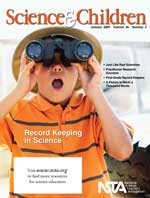Birds in January
By Peggy Ashbrook
Posted on 2009-01-06
Does it seem to you that the pigeons and seagulls that roost and circle the grocery parking lot are more active in winter? I wonder if they are really more active or just more noticeable as there is less action on the street with fewer people walking by. Winter wonderings like these make me realize how dedicated to finding out scientists must be, to persist in difficult conditions.
Talking about persistent—read how Michael Beecher, who leads the research on song sparrows at the University of Washington, and his colleagues tracked song sparrows in the November 8, 2008 issue of Science News. Reporter Susan Milius writes, “Now Beecher and Templeton are analyzing results from their Seattle field project tracking young birds out listening to music. The experimental demands were “insane,” Beecher says. Starting in spring 2006, Templeton and his tracking team equipped young male birds with little radio tags. Thanks to the miracle of modern electronics, tags weighed only about 4 percent of the weight of a song sparrow. At that size, the batteries lasted only five or six weeks, necessitating trapping the youngster at the right time for a switch.
For a year, the crew went out every day to find young birds and record the songs of nearby adults. On a “perfect” day, data gathering took only five hours. The real world of evasive birds, cranky bystanders and suburban cats was far from perfect.”
 In the January 2009 issue of Science and Children, the Early Years column activity tells how students examine feathers and group them by shape and size and color. Children can do the same kind of grouping with birds they see. All they need is a paper and pencil to record what they see so they can keep track of their data. Grouping and counting are part of a young scientist’s everyday math tasks. Where can your class observe birds?
In the January 2009 issue of Science and Children, the Early Years column activity tells how students examine feathers and group them by shape and size and color. Children can do the same kind of grouping with birds they see. All they need is a paper and pencil to record what they see so they can keep track of their data. Grouping and counting are part of a young scientist’s everyday math tasks. Where can your class observe birds?
Peggy
Disclaimer: The views expressed in this blog post are those of the author(s) and do not necessarily reflect the official position of the National Science Teaching Association (NSTA).


